
 This edition first published in 2012 by The Rosen Publishing Group, Inc. 29 East 21st Street, New York, NY 10010 Copyright 2012 Arcturus Publishing Limited All rights reserved. No part of this book may be reproduced in any form without permission in writing from the publisher, except by a reviewer. Author: Thomas Canavan Editor: Joe Harris Design: Jane Hawkins Cover design: Jane Hawkins Library of Congress Cataloging-in-Publication Data Canavan, Thomas, 1956 Mental math: 50 math super puzzles / Thomas Canavan. p. (Math standards workout) Includes bibliographical references and index. (Math standards workout) Includes bibliographical references and index.
This edition first published in 2012 by The Rosen Publishing Group, Inc. 29 East 21st Street, New York, NY 10010 Copyright 2012 Arcturus Publishing Limited All rights reserved. No part of this book may be reproduced in any form without permission in writing from the publisher, except by a reviewer. Author: Thomas Canavan Editor: Joe Harris Design: Jane Hawkins Cover design: Jane Hawkins Library of Congress Cataloging-in-Publication Data Canavan, Thomas, 1956 Mental math: 50 math super puzzles / Thomas Canavan. p. (Math standards workout) Includes bibliographical references and index. (Math standards workout) Includes bibliographical references and index.
ISBN 978-1-4488-6677-9 (library binding) ISBN 978-1-4488-6684-7 (pbk.) ISBN 978-1-4488-6690-8 (6-pack) 1. ArithmeticJuvenile literature. 2. Mathematical recreationsJuvenile literature. I. Title.
QA107.2.C345 2012 513--dc23 2011028573 Printed in China SL002075US CPSIA Compliance Information: Batch #W12YA. For further information, contact Rosen Publishing, New York, New York, at 1-800-237-9932. Contents Introduction Why do you need this book? Mental math calls on many different talents and abilities. You probably feel confident in some areas, while also realizing that there are other areas that could use improvement. The 50 puzzles in this book act as a mental workout, exercising many different mental math skills. How will this book help you at school?Mental Math complements the National Council of Teachers of Mathematics (NCTM) framework of Math Standards, providing an engaging enhancement of the curriculum in the following areas: Number and Operations Standard: Understand Meanings of Operations and HowThey InterrelateProblem Solving Standard for K12Why have we chosen these puzzles? This Math Standards Workout title features a range of interesting and absorbing puzzle types, challenging students to master the following skills to arrive at solutions:
- Build new mathematical knowledge through problem solving: e.g. How will this book help you at school?Mental Math complements the National Council of Teachers of Mathematics (NCTM) framework of Math Standards, providing an engaging enhancement of the curriculum in the following areas: Number and Operations Standard: Understand Meanings of Operations and HowThey InterrelateProblem Solving Standard for K12Why have we chosen these puzzles? This Math Standards Workout title features a range of interesting and absorbing puzzle types, challenging students to master the following skills to arrive at solutions: NOTE TO READERS If you have borrowed this book from a school or classroom library, please respect other students and DO NOT write your answers in the book. Always write your answers on a separate sheet of paper. Number Crunch Starting at the top left with the number provided, work down from one box to another, applying the mathematical instructions to your running total.
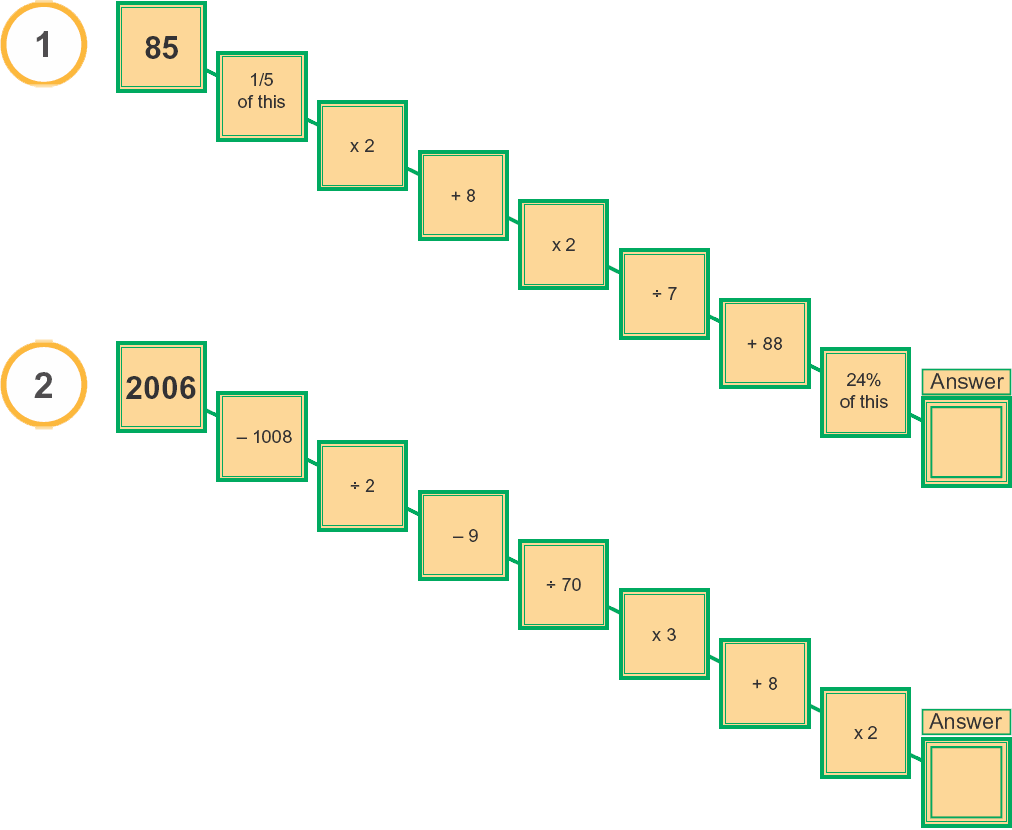 One to Nine Using the numbers one to nine, complete these six equations (three reading across and three reading downward).
One to Nine Using the numbers one to nine, complete these six equations (three reading across and three reading downward).  One to Nine Using the numbers one to nine, complete these six equations (three reading across and three reading downward).
One to Nine Using the numbers one to nine, complete these six equations (three reading across and three reading downward). Every number is used once only, and one is already in place. Write your answers on a separate sheet of paper.  Making Arrangements Arrange one each of the four numbers below, as well as one each of the symbols (times), (minus), and + (plus) in every row and column. You should arrive at the answer at the end of the row or column, making the calculations in the order in which they appear. Some are already in place.
Making Arrangements Arrange one each of the four numbers below, as well as one each of the symbols (times), (minus), and + (plus) in every row and column. You should arrive at the answer at the end of the row or column, making the calculations in the order in which they appear. Some are already in place. 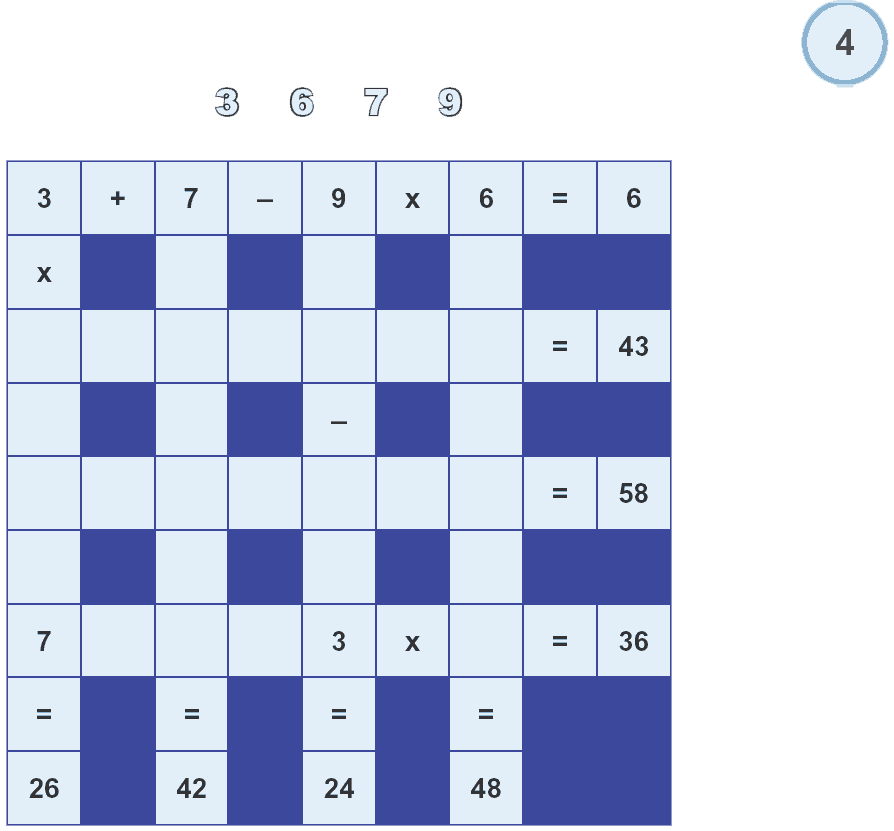 Symbol Math Each symbol stands for a different number.
Symbol Math Each symbol stands for a different number.  Symbol Math Each symbol stands for a different number.
Symbol Math Each symbol stands for a different number.
In order to reach the correct total at the end of each row and column, what is the value of the circle, pentagon, square, and star? Write your answers on a separate sheet of paper. 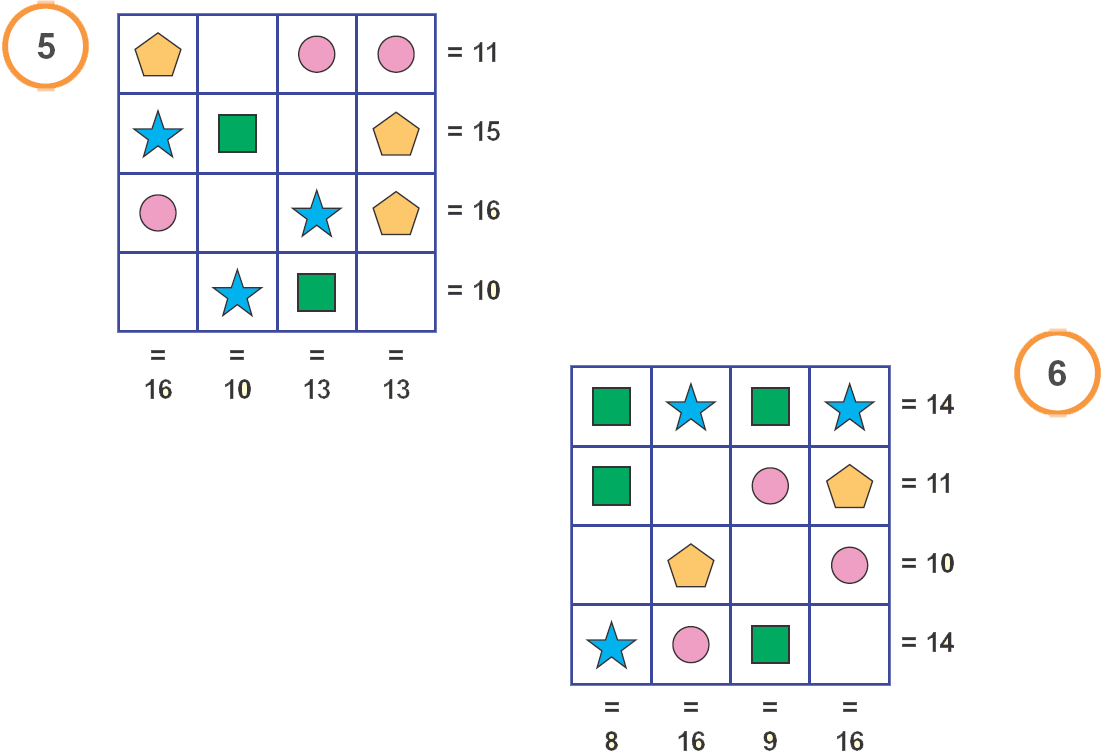 Whats the Number? In the diagram below, what number should replace the question mark? Write your answer on a separate sheet of paper.
Whats the Number? In the diagram below, what number should replace the question mark? Write your answer on a separate sheet of paper. 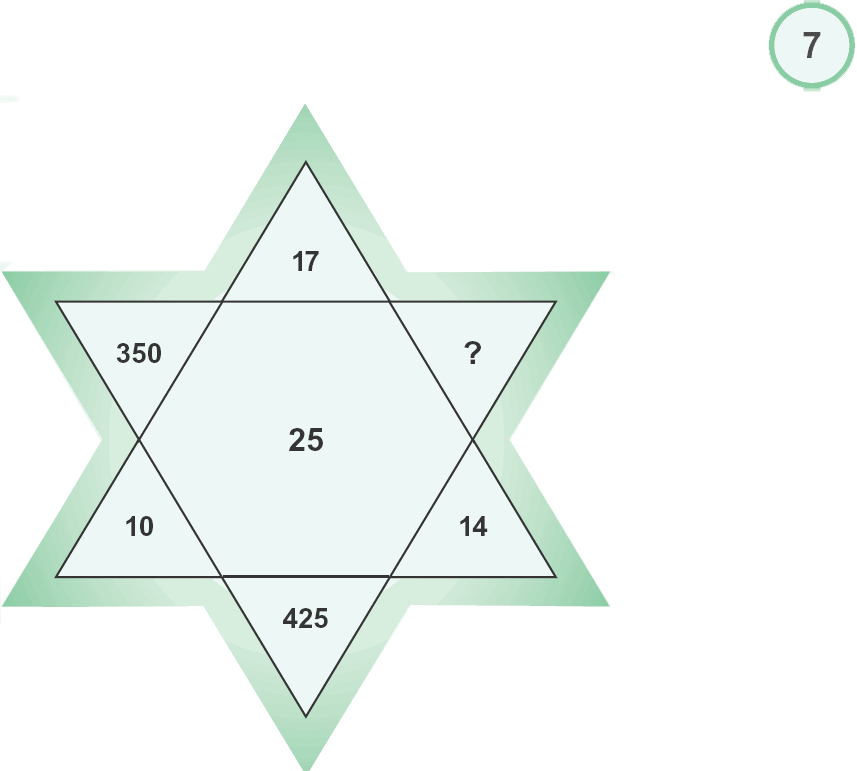 Circling In The three empty circles should contain the symbols +, , and in some order, to make a series that leads to the number in the middle. Each symbol must be used once and calculations are made in a clockwise direction. Write your answers on a separate sheet of paper.
Circling In The three empty circles should contain the symbols +, , and in some order, to make a series that leads to the number in the middle. Each symbol must be used once and calculations are made in a clockwise direction. Write your answers on a separate sheet of paper. 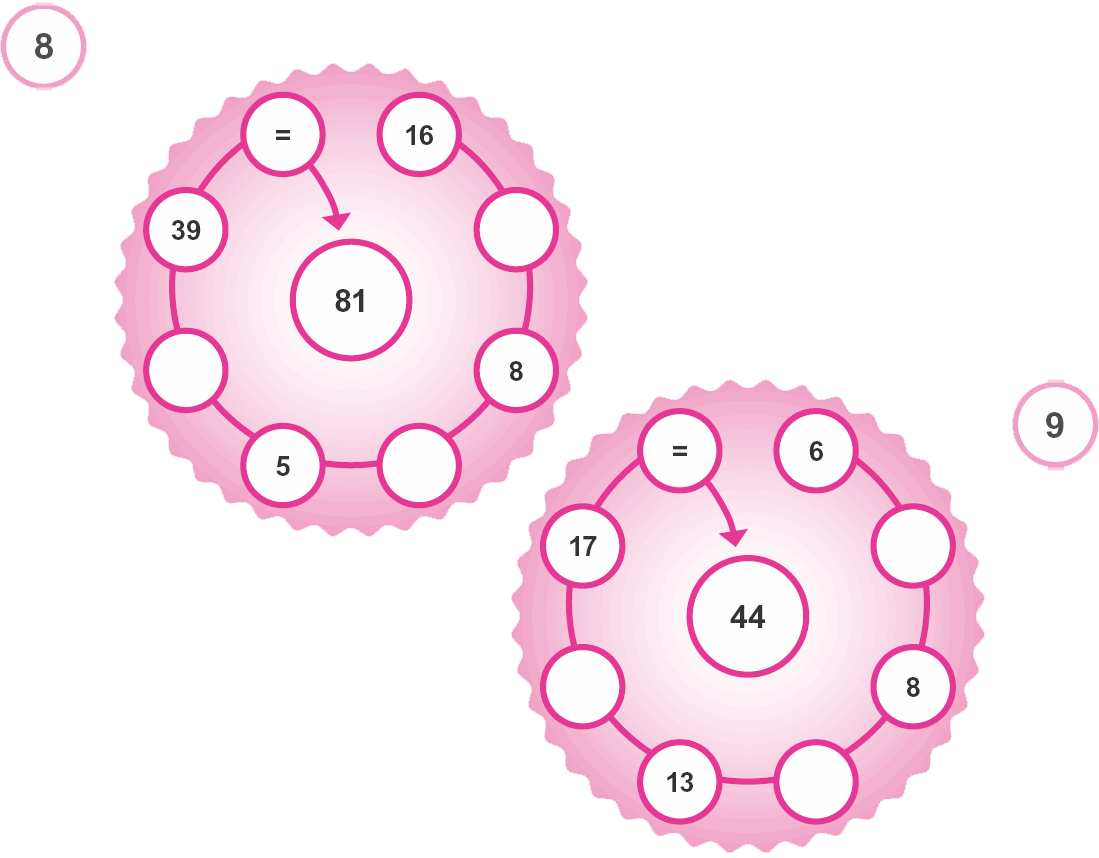 Pyramid Plus The number in each circle is the sum of the two numbers below it.
Pyramid Plus The number in each circle is the sum of the two numbers below it.
Just work out the missing numbers in every circle! Write your answers on a separate sheet of paper.  Total Concentration The blank squares below should contain whole numbers between 1 and 30 inclusive, any of which may occur more than once, or not at all. The numbers in every horizontal row add up to the totals on the right, as do the two long diagonal lines extending from corner to corner; those in every vertical column add up to the totals along the bottom. Write your answers on a separate sheet of paper.
Total Concentration The blank squares below should contain whole numbers between 1 and 30 inclusive, any of which may occur more than once, or not at all. The numbers in every horizontal row add up to the totals on the right, as do the two long diagonal lines extending from corner to corner; those in every vertical column add up to the totals along the bottom. Write your answers on a separate sheet of paper. 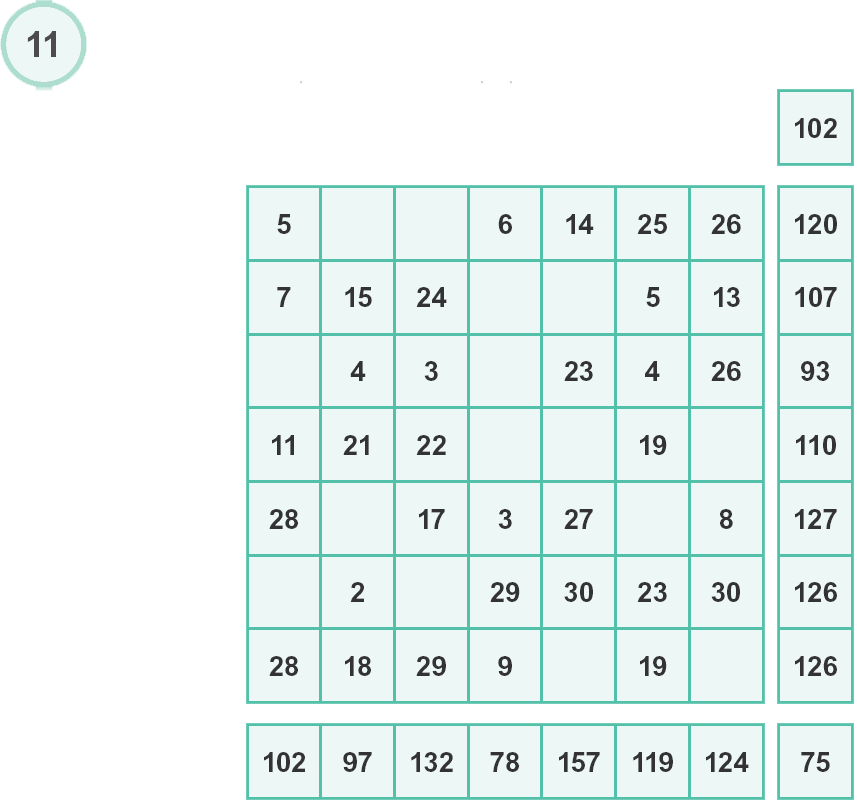 Tile Twister Place the eight tiles into the puzzle grid so that all adjacent numbers on each tile match up. Tiles may be rotated through 360 degrees, but none may be flipped over.
Tile Twister Place the eight tiles into the puzzle grid so that all adjacent numbers on each tile match up. Tiles may be rotated through 360 degrees, but none may be flipped over.
Write your answers on a separate sheet of paper. 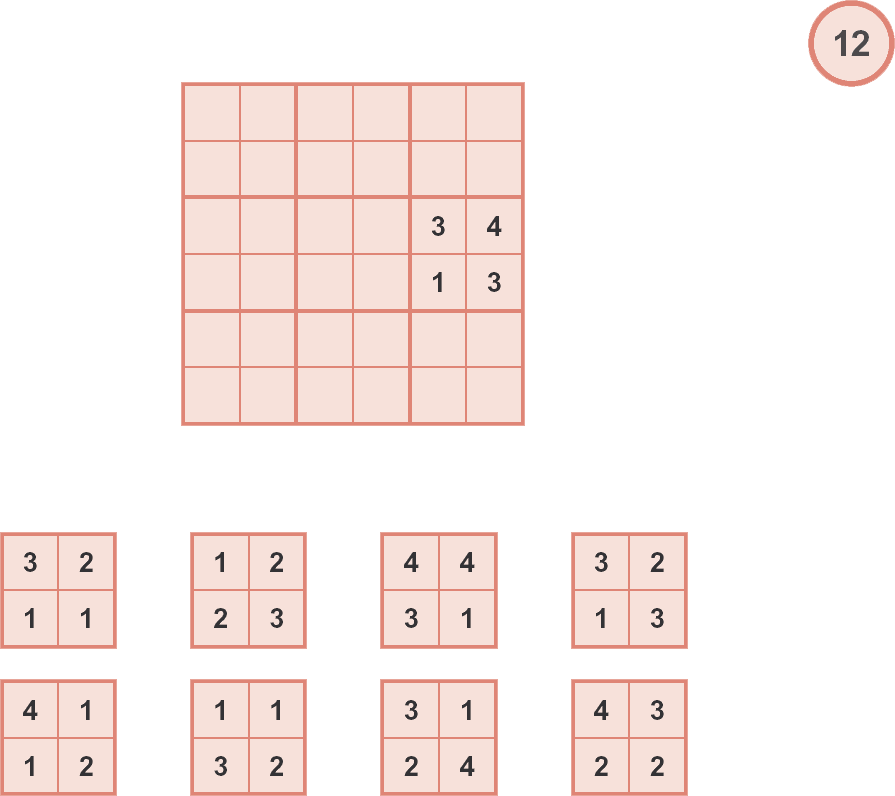 Number Path Working from one square to another, horizontally or vertically (never diagonally), draw paths to pair up each set of two matching numbers. No path may be shared, and none may enter a square containing a number or part of another path. Write your answers on a separate sheet of paper.
Number Path Working from one square to another, horizontally or vertically (never diagonally), draw paths to pair up each set of two matching numbers. No path may be shared, and none may enter a square containing a number or part of another path. Write your answers on a separate sheet of paper. 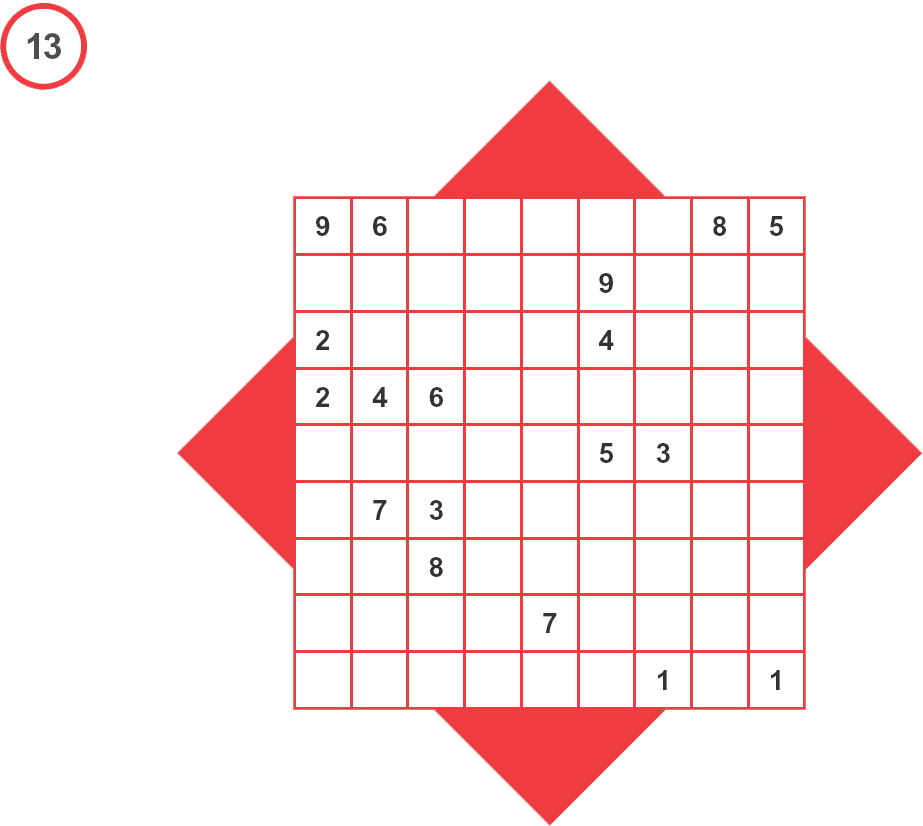
Next page

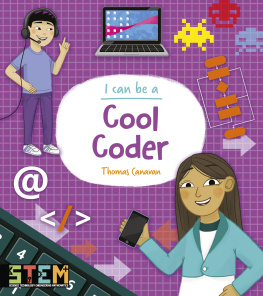


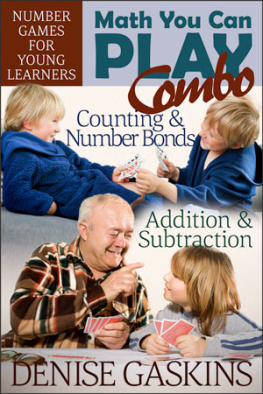
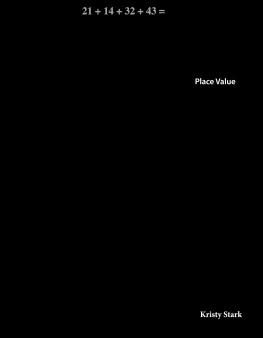
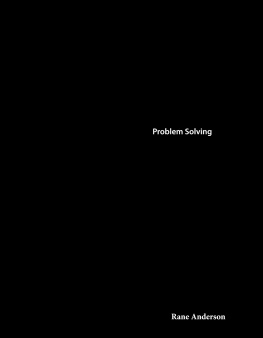
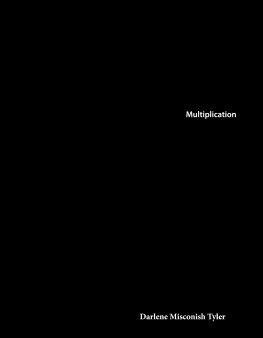
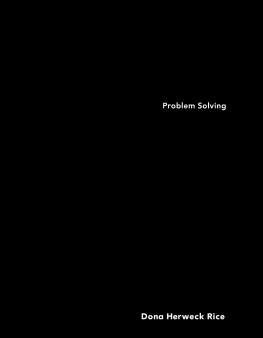
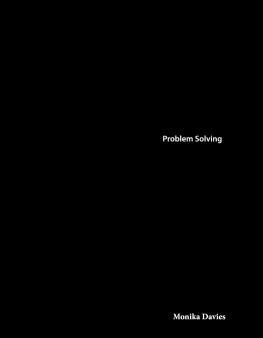

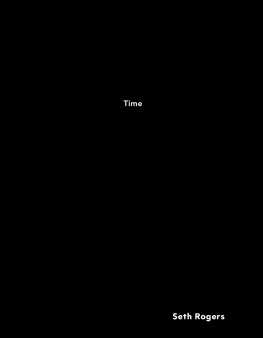
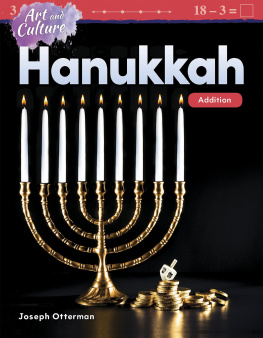

 This edition first published in 2012 by The Rosen Publishing Group, Inc. 29 East 21st Street, New York, NY 10010 Copyright 2012 Arcturus Publishing Limited All rights reserved. No part of this book may be reproduced in any form without permission in writing from the publisher, except by a reviewer. Author: Thomas Canavan Editor: Joe Harris Design: Jane Hawkins Cover design: Jane Hawkins Library of Congress Cataloging-in-Publication Data Canavan, Thomas, 1956 Mental math: 50 math super puzzles / Thomas Canavan. p. (Math standards workout) Includes bibliographical references and index. (Math standards workout) Includes bibliographical references and index.
This edition first published in 2012 by The Rosen Publishing Group, Inc. 29 East 21st Street, New York, NY 10010 Copyright 2012 Arcturus Publishing Limited All rights reserved. No part of this book may be reproduced in any form without permission in writing from the publisher, except by a reviewer. Author: Thomas Canavan Editor: Joe Harris Design: Jane Hawkins Cover design: Jane Hawkins Library of Congress Cataloging-in-Publication Data Canavan, Thomas, 1956 Mental math: 50 math super puzzles / Thomas Canavan. p. (Math standards workout) Includes bibliographical references and index. (Math standards workout) Includes bibliographical references and index. One to Nine Using the numbers one to nine, complete these six equations (three reading across and three reading downward).
One to Nine Using the numbers one to nine, complete these six equations (three reading across and three reading downward).  Making Arrangements Arrange one each of the four numbers below, as well as one each of the symbols (times), (minus), and + (plus) in every row and column. You should arrive at the answer at the end of the row or column, making the calculations in the order in which they appear. Some are already in place.
Making Arrangements Arrange one each of the four numbers below, as well as one each of the symbols (times), (minus), and + (plus) in every row and column. You should arrive at the answer at the end of the row or column, making the calculations in the order in which they appear. Some are already in place.  Symbol Math Each symbol stands for a different number.
Symbol Math Each symbol stands for a different number.  Whats the Number? In the diagram below, what number should replace the question mark? Write your answer on a separate sheet of paper.
Whats the Number? In the diagram below, what number should replace the question mark? Write your answer on a separate sheet of paper.  Circling In The three empty circles should contain the symbols +, , and in some order, to make a series that leads to the number in the middle. Each symbol must be used once and calculations are made in a clockwise direction. Write your answers on a separate sheet of paper.
Circling In The three empty circles should contain the symbols +, , and in some order, to make a series that leads to the number in the middle. Each symbol must be used once and calculations are made in a clockwise direction. Write your answers on a separate sheet of paper.  Pyramid Plus The number in each circle is the sum of the two numbers below it.
Pyramid Plus The number in each circle is the sum of the two numbers below it. Total Concentration The blank squares below should contain whole numbers between 1 and 30 inclusive, any of which may occur more than once, or not at all. The numbers in every horizontal row add up to the totals on the right, as do the two long diagonal lines extending from corner to corner; those in every vertical column add up to the totals along the bottom. Write your answers on a separate sheet of paper.
Total Concentration The blank squares below should contain whole numbers between 1 and 30 inclusive, any of which may occur more than once, or not at all. The numbers in every horizontal row add up to the totals on the right, as do the two long diagonal lines extending from corner to corner; those in every vertical column add up to the totals along the bottom. Write your answers on a separate sheet of paper.  Tile Twister Place the eight tiles into the puzzle grid so that all adjacent numbers on each tile match up. Tiles may be rotated through 360 degrees, but none may be flipped over.
Tile Twister Place the eight tiles into the puzzle grid so that all adjacent numbers on each tile match up. Tiles may be rotated through 360 degrees, but none may be flipped over. Number Path Working from one square to another, horizontally or vertically (never diagonally), draw paths to pair up each set of two matching numbers. No path may be shared, and none may enter a square containing a number or part of another path. Write your answers on a separate sheet of paper.
Number Path Working from one square to another, horizontally or vertically (never diagonally), draw paths to pair up each set of two matching numbers. No path may be shared, and none may enter a square containing a number or part of another path. Write your answers on a separate sheet of paper. 